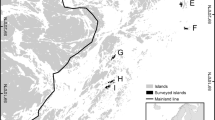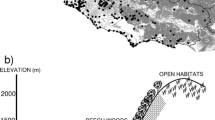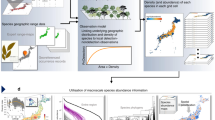Abstract
Where distribution maps do not exist ecologists often use regional species lists to examine geographic patterns of species richness, despite the fact that inconsistent grain sizes across areas may complicate interpretation of the results. We compare patterns of species richness of European butterflies and dragonflies using regional species lists (varying grain size) and regular grids (constant grain size). We asked if species lists give results comparable to the gridded data when used in simple macroecological analysis of environmental correlates of species richness. We generated two equal-area grids (220 × 220 km and 440 × 440 km) to map the richness gradients and model species richness as a function of actual evapotranspiration (AET) and range in elevation. Then we used species checklists of 33 administrative regions of unequal sizes to construct the same environmental models while accounting for differences in area. Analysis of butterfly checklist data produced comparable results to the analysis of gridded data. In contrast, dragonfly checklist data had a distorted spatial pattern and much weaker associations with environmental variables than the gridded data. The robustness of checklist data appears to be variable, even within a single geographical region, and may not generate patterns congruent with those found using equal-area grids.


Similar content being viewed by others
References
Ahn CH, Tateishi R (1994) Development of a global 30 minute grid potential evapotranspiration dataset. J JSPRS 33:12–21
Arrhenius O (1921) Species and area. J Ecol 9:95–99. doi:10.2307/2255763
Barcena S, Real R, Olivero J, Vargas JM (2004) Latitudinal trends in breeding waterbird species richness in Europe and their environmental correlates. Biodivers Conserv 13:1997–2014. doi:10.1023/B:BIOC.0000040000.23854.b9
Baselga A (2008) Determinants of species richness, endemism and turnover in European longhorn beetles. Ecography 31:263–271. doi:10.1111/j.0906-7590.2008.5335.x
Beale CM, Lennon JJ, Elston DA et al (2007) Red herrings remain in geographical ecology: a reply to Hawkins et al. (2007). Ecography 30:845–847. doi:10.1111/j.2007.0906-7590.05338.x
Beck J, Kitching IJ, Linsenmair KE (2006) Determinants of regional species richness: an empirical analysis of the number of hawkmoth species (Lepidoptera: Sphingidae) on the Malesian archipelago. J Biogeogr 33:694–706. doi:10.1111/j.1365-2699.2005.01418.x
Bini LM, Diniz-Filho JAF, Rangel TFLVP et al (2009) Parameter estimation in geographical ecology: and empirical evaluation of spatial and non-spatial regression. Ecography 32:1–12
Clarke HD, Funk VA (2005) Using checklists and collections data to investigate plant diversity: II. An analysis of five floras from northeastern South America. Proc Acad Nat Sci Philadelphia 154:29–37. doi:10.1635/0097-3157(2004)154[0029:UCACDT]2.0.CO;2
Dijkstra KB, Lewington R (2006) Field guide to the dragonflies of Britain and Europe. British Wildlife Publishing, Gillingham
Diniz-Filho JAF, Hawkins BA, Bini LM et al (2007) Are spatial regression methods a panacea or a pandora’s box? Ecography 30:848–851. doi:10.1111/j.2007.0906-7590.05358.x
Feuerer T, Hawksworth DL (2007) Biodiversity of lichens, including a world-wide analysis of checklist data based on Takhtajan’s floristic regions. Biodivers Conserv 16:85–98. doi:10.1007/s10531-006-9142-6
Hawkins BA, Porter EE (2003) Water-energy balance and the geographic pattern of species richness of western Palearctic butterflies. Ecol Entomol 28:678–686. doi:10.1111/j.1365-2311.2003.00551.x
Hawkins BA, Field R, Cornell HV et al (2003a) Energy, water, and broad-scale geographic patterns of species richness. Ecology 84:3105–3117. doi:10.1890/03-8006
Hawkins BA, Porter EE, Diniz-Filho JAF et al (2003b) Productivity and history as predictors of the latitudinal diversity gradient of terrestrial birds. Ecology 84:1608–1623. doi:10.1890/0012-9658(2003)084[1608:PAHAPO]2.0.CO;2
Hawkins BA, Rueda M, Rodríguez MA (2008) What do range maps and surveys tell us about diversity patterns? Folia Geobot 43:345–355. doi:10.1007/s12224-008-9007-8
Heegaard E, Okland RH, Bratli H et al (2007) Regularity of species richness relationships to patch size and shape. Ecography 30:589–597
Hof C, Brändle M, Brandl R (2008) Latitudinal variation of diversity in European freshwater animals is not concordant across habitat types. Glob Ecol Biogeogr 17:539–546. doi:10.1111/j.1466-8238.2008.00394.x
Hurlbert AH, Jetz W (2007) Species richness, hotspots, and the scale dependence of range maps in ecology and conservation. Proc Natl Acad Sci USA 104:13384–13389. doi:10.1073/pnas.0704469104
Hurlbert AH, White EP (2005) Disparity between range map- and survey-based analyses of species richness: patterns, processes and implications. Ecol Lett 8:319–327. doi:10.1111/j.1461-0248.2005.00726.x
Kalmar A, Currie DJ (2007) A unified model of avian species richness on islands and continents. Ecology 88:1309–1321. doi:10.1890/06-1368
Keil P, Simova I, Hawkins BA (2008a) Water-energy and the geographical species richness pattern of European and North African dragonflies (Odonata). Insect Conserv Divers 1:142–150. doi:10.1111/j.1752-4598.2008.00019.x
Keil P, Dziock F, Storch D (2008b) Geographical patterns of hoverfly (Diptera, Syrphidae) functional groups in Europe: inconsistency in environmental correlates and latitudinal trends. Ecol Entomol 33:748–757
Kier G, Mutke J, Dinerstein E et al (2005) Global patterns of plant diversity and floristic knowledge. J Biogeogr 32:1107–1116. doi:10.1111/j.1365-2699.2005.01272.x
Konvicka M, Fric Z, Benes J (2006) Butterfly extinctions in European states: do socioeconomic conditions matter more than physical geography? Glob Ecol Biogeogr 15:82–92. doi:10.1111/j.1466-822X.2006.00188.x
Kunin WE (1997) Sample shape, spatial scale and species counts: implications for reserve design. Biol Conserv 82:369–377. doi:10.1016/S0006-3207(97)00042-6
Legendre P (1993) Spatial autocorrelation—trouble or new paradigm? Ecology 74:1659–1673
Lennon JJ (2000) Red-shifts and red herrings in geographical ecology. Ecography 23:101–113. doi:10.1034/j.1600-0587.2000.230111.x
Palmer MW, McGlinn D, Fridley JD (2008) Artifacts and artifictions in biodiversity research. Folia Geobot 43:245–257. doi:10.1007/s12224-008-9012-y
Qian H (2008) Effects of historical and contemporary factors on global patterns in avian species richness. J Biogeogr 35:1362–1373. doi:10.1111/j.1365-2699.2008.01901.x
Rahbek C, Graves GR (2001) Multiscale assessment of patterns of avian species richness. Proc Natl Acad Sci USA 98:4534–4539. doi:10.1073/pnas.071034898
Ruggiero A, Hawkins BA (2008) Why do mountains support so many species of birds? Ecography 31:306–315. doi:10.1111/j.0906-7590.2008.05333.x
Tolman T (1997) Butterflies of Britain and Europe. Harper Collins, London
Ulrich W, Buszko J (2003) Species-area relationships of butterflies in Europe and species richness forecasting. Ecography 26:365–373. doi:10.1034/j.1600-0587.2003.03441.x
van Swaay CAM, Warren MS (1999) Red data book of European butterflies (Rhopalocera). Council of Europe Publishing, Strasbourg
Whittaker RJ, Willis KJ, Field R (2001) Scale and species richness: towards a general, hierarchical theory of species diversity. J Biogeogr 28:453–470. doi:10.1046/j.1365-2699.2001.00563.x
Acknowledgements
We are grateful to David Storch, Irena Simova, Jiri Reif, Mrdka Z. Krtka, Andrés Baselga, Martin Konvicka and an anonymous referee for comments on the manuscript. The study was supported by the Grant Agency of Charles University (GAUK 106108), by the Grant Agency of the Academy of Sciences of the CR (IAA601970801) and by the Czech Ministry of Education (Grant LC06073).
Author information
Authors and Affiliations
Corresponding author
Appendix
Appendix
Mismatches between the sources for the GRID data and the LIST data
Butterfly species complexes represented by one map in Tolman (1997) but which are two or more species in van Swaay and Warren (1999): Spialia sertorius (Hoffmannsegg), Pyrgus carlinae (Rambur), Meleageria coridon (Poda), Agrodiaetus dolus (Hübner), Plebeius pylaon (Fischer von Waldheim), Aricia agestis (Denis & Schiffermüller), Lasiommata megera (Linnaeus). Butterfly species complexes represented as one species in van Swaay and Warren (1999) but which have two maps in Tolman (1997): Pontia daplidice (Linnaeus). Butterfly species listed only in van Swaay and Warren (1999): Pyrgus bellieri (Oberthür), Agrodiaetus fulgens (De Sagarra), Neolycaena rhymnus (Eversmann), Clossiana selenis (Eversmann), Triphysa phyrne (Pallas), Melanargia pherusa (Boisduval), Tomares callimachus (Eversmann).
The set of dragonfly species that were treated in Dijkstra and Lewington (2006) (the source for the GRID data) was identical to the set of species in Fauna Europaea (the source for the LIST data) except for Pyrrhosoma elisabethe (Schmidt) and Cordulegaster picta (Selys) that are absent in the Fauna Europaea database.
Rights and permissions
About this article
Cite this article
Keil, P., Hawkins, B.A. Grids versus regional species lists: are broad-scale patterns of species richness robust to the violation of constant grain size?. Biodivers Conserv 18, 3127–3137 (2009). https://doi.org/10.1007/s10531-009-9631-5
Received:
Accepted:
Published:
Issue Date:
DOI: https://doi.org/10.1007/s10531-009-9631-5




